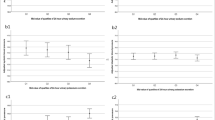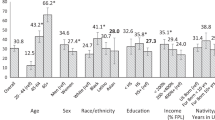Abstract
Habitual levels of dietary sodium and potassium are correlated with age-related increases in blood pressure (BP) and likely have a role in this phenomenon. Although extensive published evidence exists from randomized trials, relatively few large-scale community surveys with multiple 24-h urine collections have been reported. We obtained three 24-h samples from 2704 individuals from Nigeria, Jamaica and the United States to evaluate patterns of intake and within-person relationships with BP. The average (±s.d.) age and weight of the participants across all the three sites were 39.9±8.6 years and 76.1±21.2 kg, respectively, and 55% of the total participants were females. Sodium excretion increased across the East–West gradient (for example, 123.9±54.6, 134.1±48.8, 176.6±71.0 (±s.d.) mmol, Nigeria, Jamaica and US, respectively), whereas potassium was essentially unchanged (for example, 46.3±22.9, 40.7±16.1, 44.7±16.4 (±s.d.) mmol, respectively). In multivariate analyses both sodium (positively) and potassium (negatively) were strongly correlated with BP (P<0.001); quantitatively the association was stronger, and more consistent in each site individually, for potassium. The within-population day-to-day variation was also greater for sodium than for potassium. Among each population group, a significant correlation was observed between sodium and urine volume, supporting the prior finding of sodium as a determinant of fluid intake in free-living individuals. These data confirm the consistency with the possible role of dietary electrolytes as hypertension risk factors, reinforcing the relevance of potassium in these populations.
This is a preview of subscription content, access via your institution
Access options
Subscribe to this journal
Receive 12 digital issues and online access to articles
$119.00 per year
only $9.92 per issue
Buy this article
- Purchase on SpringerLink
- Instant access to full article PDF
Prices may be subject to local taxes which are calculated during checkout



Similar content being viewed by others
References
Appel LJ, Brands MW, Daniels SR, Karanja N, Elmer PJ, Sacks FM . Dietary approaches to prevent and treat hypertension: a scientific statement from the American Heart Association. Hypertension 2006; 47 (2): 296–308.
He FJ, MacGregor GA . A comprehensive review on salt and health and current experience of worldwide salt reduction programmes. J Hum Hypertens 2009; 23 (6): 363–384.
WHO Forum on Reducing Salt Intake in Populations. Reducing Salt Intake in Populations: Report of a WHO Forum and Technical Meeting, 5–7 October 2006, Paris, France. World Health Organization: Paris, France, 2006.
Brown IJ, Tzoulaki I, Candeias V, Elliott P . Salt intakes around the world: implications for public health. Int J Epidemiol 2009; 38 (3): 791–813.
Kurlansky M . Salt—a World History. Penguin Books: New York, 2002.
Cooper RS, Rotimi CN, Kaufman JS, Muna WF, Mensah GA . Hypertension treatment and control in sub-Saharan Africa: the epidemiological basis for policy. BMJ 1998; 316 (7131): 614–617.
Cooper RS, Tayo B . Geographic patterns of hypertension: a global perspective. In: Izzo JL, Sica DA, Black HR (eds). Hypertension Primer: the Essentials of High Blood Pressure: Basic Science, Population Science, and Clinical Management, 4th edn. Council on High Blood Pressure Research (American Heart Association): Dallas, Texas, 2008, pp 239–241.
Institute of Medicine. Strategies to Reduce Sodium Intake in the United States. The National Academies: Washington, DC, 2010.
He FJ, Marrero NM, MacGregor GA . Salt intake is related to soft drink consumption in children and adolescents: a link to obesity? Hypertension 2008; 51 (3): 629–634.
He FJ, Markandu ND, Sagnella GA, MacGregor GA . Effect of salt intake on renal excretion of water in humans. Hypertension 2001; 38 (3): 317–320.
Mattes RD . Dietary compensation by humans for supplemental energy provided as ethanol or carbohydrate in fluids. Physiol Behav 1996; 59 (1): 179–187.
Dyer AR, Shipley M, Elliott P . Urinary electrolyte excretion in 24 h and blood pressure in the INTERSALT Study. I. Estimates of reliability. The INTERSALT Cooperative Research Group. Am J Epidemiol 1994; 139 (9): 927–939.
Cooper R, Rotimi C, Ataman S, McGee D, Osotimehin B, Kadiri S et al. The prevalence of hypertension in seven populations of West African origin. Am J Public Health 1997; 87 (2): 160–168.
Adeyemo AA, Prewitt TE, Luke A, Omotade OO, Rotimi CN, Brieger WR et al. The feasibility of implementing a dietary sodium reduction intervention among free-living normotensive individuals in south west Nigeria. Ethn Dis 2002; 12 (2): 207–212.
Forrester T, McFarlane-Anderson N, Bennet F, Wilks R, Puras A, Cooper R et al. Angiotensinogen and blood pressure among blacks: findings from a community survey in Jamaica. J Hypertens 1996; 14 (3): 315–321.
Liu K, Cooper R, McKeever J, McKeever P, Byington R, Soltero I et al. Assessment of the association between habitual salt intake and high blood pressure: methodological problems. Am J Epidemiol 1979; 110 (2): 219–226.
Cooper R, Puras A, Tracy J, Kaufman J, Asuzu M, Ordunez P et al. Evaluation of an electronic blood pressure device for epidemiological studies. Blood Press Monit 1997; 2 (1): 35–40.
WHO Regional Office for Europe. Estimation of sodium intake and output: review of methods and recommendations for epidemiological studies. In: WHO Regional Office for Europe (ed). Report on a WHO Meeting by the WHO Collaborating Center for Research and Training in Cardiovascular Diseases. World Health Organization: Geneva, 1984.
Malekshah AF, Kimiagar M, Saadatian-Elahi M, Pourshams A, Nouraie M, Goglani G et al. Validity and reliability of a new food frequency questionnaire compared to 24 h recalls and biochemical measurements: pilot phase of Golestan cohort study of esophageal cancer. Eur J Clin Nutr 2006; 60 (8): 971–977.
Jequier E, Tappy L . Regulation of body weight in humans. Physiol Rev 1999; 79 (2): 451–480.
Institute of Medicine. Dietary Reference Intakes for Energy, Carbohydrate, Fiber, Fat, Fatty Acids, Cholesterol, Protein, and Amino Acids (Macronutrients). The National Academies Press: Washington, DC, 2005.
Cooper RS, Kaufman JS . Race and hypertension: science and nescience. Hypertension 1998; 32 (5): 813–816.
Cooper RS, Wolf-Maier K, Luke A, Adeyemo A, Banegas JR, Forrester T et al. An international comparative study of blood pressure in populations of European vs African descent. BMC Med 2005; 3: 2.
Cooper R, Soltero I, Liu K, Berkson D, Levinson S, Stamler J . The association between urinary sodium excretion and blood pressure in children. Circulation 1980; 62 (1): 97–104.
Intersalt Cooperative Research Group. Intersalt: an international study of electrolyte excretion and blood pressure. Results for 24 h urinary sodium and potassium excretion. Intersalt Cooperative Research Group. BMJ 1988; 297 (6644): 319–328.
Cutler JA, Follmann D, Allender PS . Randomized trials of sodium reduction: an overview. Am J Clin Nutr 1997; 65 (2 Suppl): 643S–651S.
He FJ, MacGregor GA . Importance of salt in determining blood pressure in children: meta-analysis of controlled trials. Hypertension 2006; 48 (5): 861–869.
Sacks FM, Svetkey LP, Vollmer WM, Appel LJ, Bray GA, Harsha D et al. Effects on blood pressure of reduced dietary sodium and the Dietary Approaches to Stop Hypertension (DASH) diet. DASH-Sodium Collaborative Research Group. N Engl J Med 2001; 344 (1): 3–10.
Whelton PK, He J, Cutler JA, Brancati FL, Appel LJ, Follmann D et al. Effects of oral potassium on blood pressure. Meta-analysis of randomized controlled clinical trials. JAMA 1997; 277 (20): 1624–1632.
Forrester T, Adeyemo A, Soarres-Wynter S, Sargent L, Bennett F, Wilks R et al. A randomized trial on sodium reduction in two developing countries. J Hum Hypertens 2005; 19 (1): 55–60.
Aviv A, Hollenberg NK, Weder A . Urinary potassium excretion and sodium sensitivity in blacks. Hypertension 2004; 43 (4): 707–713.
He FJ, Marciniak M, Visagie E, Markandu ND, Anand V, Dalton RN et al. Effect of modest salt reduction on blood pressure, urinary albumin, and pulse wave velocity in White, Black, and Asian mild hypertensives. Hypertension 2009; 54 (3): 482–488.
Morris Jr RC, Sebastian A, Forman A, Tanaka M, Schmidlin O . Normotensive salt sensitivity: effects of race and dietary potassium. Hypertension 1999; 33 (1): 18–23.
Palacios C, Wigertz K, Martin BR, Braun M, Pratt JH, Peacock M et al. Racial differences in potassium homeostasis in response to differences in dietary sodium in girls. Am J Clin Nutr 2010; 91 (3): 597–603.
Weinberger MH, Luft FC, Bloch R, Henry DP, Pratt JH, Weyman AE et al. The blood pressure-raising effects of high dietary sodium intake: racial differences and the role of potassium. J Am Coll Nutr 1982; 1 (2): 139–148.
Kotchen TA, Grim CE, Kotchen JM, Krishnaswami S, Yang H, Hoffmann RG et al. Altered relationship of blood pressure to adiposity in hypertension. Am J Hypertens 2008; 21 (3): 284–289.
Bibbins-Domingo K, Chertow GM, Coxson PG, Moran A, Lightwood JM, Pletcher MJ et al. Projected effect of dietary salt reductions on future cardiovascular disease. N Engl J Med 2010; 362 (7): 590–599.
Strazzullo P, D'Elia L, Kandala NB, Cappuccio FP . Salt intake, stroke, and cardiovascular disease: meta-analysis of prospective studies. BMJ 2009; 339: b4567.
Acknowledgements
This work was supported by the National Institutes of Health, grant numbers R37HL045508 and R01HL053353.
Author information
Authors and Affiliations
Corresponding author
Ethics declarations
Competing interests
The authors declare no conflict of interest.
Rights and permissions
About this article
Cite this article
Tayo, B., Luke, A., McKenzie, C. et al. Patterns of sodium and potassium excretion and blood pressure in the African Diaspora. J Hum Hypertens 26, 315–324 (2012). https://doi.org/10.1038/jhh.2011.39
Received:
Revised:
Accepted:
Published:
Issue Date:
DOI: https://doi.org/10.1038/jhh.2011.39
Keywords
This article is cited by
-
Association of urinary sodium excretion with blood pressure and risk factors associated with hypertension among Cameroonian pygmies and bantus: a cross-sectional study
BMC Cardiovascular Disorders (2018)
-
High-sensitivity ion detection at low voltages with current-driven organic electrochemical transistors
Nature Communications (2018)
-
Kidney disease and obesity: epidemiology, mechanisms and treatment
Nature Reviews Nephrology (2017)
-
Ethnic differences in prevalence and risk factors for hypertension in the Suriname Health Study: a cross sectional population study
Population Health Metrics (2016)
-
Salt intakes in sub-Saharan Africa: a systematic review and meta-regression
Population Health Metrics (2016)



